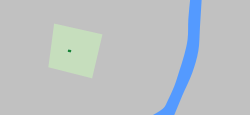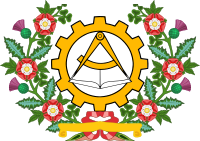Socialist State of Gymnasium
Socialist State of Gymnasium Socialistický stát Gymnázium | |||||||||
|---|---|---|---|---|---|---|---|---|---|
| Motto: none | |||||||||
| Anthem: none | |||||||||
 | |||||||||
| Capital and largest city | Sušice | ||||||||
| Official languages | Czech | ||||||||
| Demonym(s) | Gymnazists | ||||||||
| Government | Socialist state (de iure) Anarchy (de facto) | ||||||||
| Legislature | Council | ||||||||
| Establishment | |||||||||
• Independence declared | 2 September 2017 | ||||||||
• Establishing Council meeting | 4 September 2017 | ||||||||
• Provisional Constitution adopted | 10 January 2018 | ||||||||
| Area | |||||||||
• Total | 0.00004 km2 (1.5×10−5 sq mi)[a] | ||||||||
| Population | |||||||||
• November 2017 census | 6 | ||||||||
| |||||||||
| |||||||||
Socialist State of Gymnasium (Czech: Socialistický stát Gymnázium), often abbreviated SSG, was a small self-proclaimed country in Central Europe within the territory of the modern Gymnasium State, created in 2017 when it declared independence from the Czech Republic. Also retroactively called the First Republic, it was the first instance of a Gymnasian state to exist, operating for four months until it was succeeded by the Second Republic at the beginning of 2018. The Socialist State of Gymnasium was officially an unitary isocratic socialist state, however for a large portion of its history no actual government exercised any power. Located within a single room in the gymnasium in what is now Sušice-Gympl, it was not only landlocked, but also had no access to the airspace.
History
On 2 September 2017, Tomáš Falešník declared the independence of the Socialist State of Gymnasium, granting citizenship to three of his classmates. Shortly after the four students, considered the unofficial founding fathers by later Gymnasian historiography, met in the claimed territory for the first ever government session on 4 September and retroactively confirmed the declaration to 1 September. During this session, the Council's powers were confirmed and an official flag was adopted. In later sessions held during September citizenship was granted to a small number of interested classmates, first legislation was discussed and a further territorial claim in Kraninikeria, a small strip of land along the Otava river just south of Sušice. However, no laws were ultimately passed and the Socialist State would be nearly abandoned by early October. Although the Socialist State had established presence on MicroWikia, it never participated in any micronational diplomacy and the page would eventually be deleted by the website administrators.
In November and early December the Socialist State of Gymnasium was revived as more people became interested in the concept. The sudden surge in population and recent experience with inactivity of the Council resulted in the decision to reform the micronation's governance. On 18 November the micronation is recorded to have used the name Unofficial State of Gymnasium from when it established presence in the Czech sector by creating an article on the Czech MicroWiki, discontinuing the classification of a socialist state to avoid associations with the totalitarian and authoritarian Marxist-Leninist regimes of the Eastern Bloc. This date usually marks the beginning of the Transitional Period, during which the Council, over the span of December 2017 and early January 2018, outlined the government reforms adopted by the Provisional Constitution on 10 January 2018, shortly after the first presidential election two days before. The Provisional Constitution replaced the Council with the Government and marked the definite end of the Socialist State in favour of what is nowadays called the Second Republic. In the past, the dates 31 December 2017 and 1 January 2018 were also sometimes used as the date of dissolution of the Socialist State, but these dates are arbitrary with no reasoning behind them.
At the end of February 2018, a group of people who would later form the leadership of the Social Liberals briefly contemplated launching a coup d'état and reestablishing the Socialist State of Gymnasium under an actual one-party dictatorship, but no serious effort was dedicated towards planning and no coup was ever attempted. Instead, the Republic of Kraninikeria was formed on 2 March 2018 but it did not have any significant impact on the development of the Gymnasium State.
Government
Socialist State of Gymnasium was officially a unitary direct democratic socialist state, although its form of government could also be classified as an isocracy as all of its held equal political power. Despite using communist symbolism in form of socialist heraldry, including the hammer and sickle popularised by the Russian Revolution, the micronation never claimed to be communist, albeit its form of government was later described as council communism by outside observers. Unlike other past socialist states, which were usually ruled by a single political party, the Socialist State of Gymnasium had no parties, but they weren't expressly banned as was the case later during the Second Republic.
The executive power and legislative powers were both held by the Council of the Socialist State of Gymnasium (Czech: Rada Socialistického státu Gymnázium), which made decisions based on the consensus of its members. The Council was also the collective head of state responsible for foreign representation. All citizens of the Socialist State were members of the Council, which meant the body grew from four members at formation up to eleven at the adoption of the Provisional Constitution. The Council served as a basis for later Gymnasian legislatures, including the modern Senate.
Geography
Socialist State of Gymnasium was located entirely within the territory currently claimed by the Gymnasium State as Sušice-Gympl. Consisting of a single classroom of the Sušice gymnasium, not only was the claimed territory landlocked by the neighbouring Czech Republic, but there were also no claims to any national airspace above the room's ceiling or underground portions under the room's floor. The Socialist State Gymnasium was only accessible from an entrance on the eastern end of its southern border. While other theoretical entrances existed in the form of a number of windows on the northern border, they were inaccessible as the claimed classroom was located on the first floor of the building. No official measurement of the claimed territory was conducted, but an estimate of 160 m³ was provided as the claimed volume. This figure is however likely incorrect. While a sink was located within the claimed territory, no permanent bodies of water existed on the claim.


